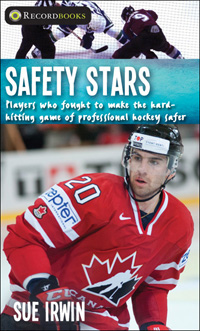| ________________
CM . . .
. Volume XXI Number 36. . . .May 22, 2015

 |
Safety Stars: Players Who Fought to Make the Hard-Hitting Game of Professional Hockey Safer. (Recordbooks).
Sue Irwin.
Toronto, ON: James Lorimer, 2015.
135 pp., pbk., hc. & ebook, $9.95 (pbk.), $16.95 (hc.), $8.95 (ebook).
ISBN 978-1-4594-0846-3 (pbk.), ISBN 978-1-4594-0847-0 (hc.), ISBN 978-1-4594-0848-7 (ebook).
Subject Headings:
Hockey-Safety measures-Juvenile literature.
Hockey-Equipment and supplies-Juvenile literature.
Grades 3-4 / Ages 8-9.
Review by Thomas F. Chambers.
**½ /4
|
| |
|

excerpt:
A concussion is called an “invisible injury.” There are no cuts, bruises or broken bones. A headache is the most common warning sign. Hurt players might also feel dizzy or sick to their stomach. They might say that things look fuzzy. They may act confused or be unable to concentrate. Some people may feel sad or moody. They may be drowsy, or have a hard time falling asleep. In the worst cases, they may pass out. A person might have many of these symptoms, or just one.
As the title indicates, Safety Stars is about hockey players who tried to make their game a safer one. The initial example is former Montreal Canadians goal tender Jacques Plante, the first goalie to wear a mask. Without one, Plante realized after being hit in the face, a goalie could easily be seriously injured, or even killed, by a puck which can travel at 160 kms an hour. Strange as it may seem today when goalies are required to wear masks and the other players must wear helmets in order to try and prevent concussions, team managers were initially strongly opposed. They believed that protecting the head would make players less successful. As Stan Mikita, former Black Hawks star, said, “Management was definitely against it.”
In addition to Safety Stars’s 11 chapters, which vary from six to twelve pages, the book has a prologue, an epilogue, an excellent glossary, with terms such as “Traumatic Brain Injury” (TBI) and “Cardiopulmonary Resuscitation” (CPR) which children may not know, plus an index. Eight decorative black and white photographs are distributed throughout the book. Each chapter has at least one sidebar. One example is “The Secret of Willie O’Ree”, the first black NHL player who played for 20 years with only one eye. Safety Stars could be used for recreational reading. One weakness is the book’s title. It is too complicated and is not likely to grab a young reader’s attention.
The “Prologue” introduces the violence that dominates the game today in spite of the efforts to reduce it. A child who reads this book and then watches an NHL game will realize that very little has been done to make the game safer since Jacques Plante first wore a mask in 1959 even though masks and helmets are now worn by all players. Even with all the protective gear NHL players wear, hockey is a very dangerous game.
Concussions are still quite common, and that is the theme of the “Epilogue” which discusses the serious concussion suffered by Pittsburgh star Sidney Crosby which kept him off the ice for two seasons. Even though talented players like Crosby get hurt, the violence continues. A big reason for this is that the fans love it. They are supported by TV personality Don Cherry whose “Rock’em Sock’em” style of hockey sells tickets. Cherry expressed his hockey philosophy clearly when he said the problem with the Toronto Maple Leafs, who had a dismal season in 2015, was that the team had “too many sucks” and not enough enforcers punching other players. (See National Post) Even though many hockey players have tried to make hockey a safer game and they now have protective clothing, they have, so far, lost the struggle. Hockey is one of the most brutal professional sports.
Sue Irwin, the author of Safety Stars, a school teacher and hockey fan, lives in Hamilton, ON. Safety Stars is her first book, but she has written for some other children's publications, including Reading A-Z, Highlights Magazine, and AppleSeeds Magazine.
Recommended.
Thomas F. Chambers, a retired college professor and author, lives in North Bay, ON.

To comment
on this title or this review, send mail to cm@umanitoba.ca.
Copyright © the Manitoba Library Association. Reproduction for personal
use is permitted only if this copyright notice is maintained. Any
other reproduction is prohibited without permission.
Next Review | Table of Contents For This Issue - May 22, 2015
CM Home | Back Issues
| Search
| CM Archive
| Profiles Archive
|
